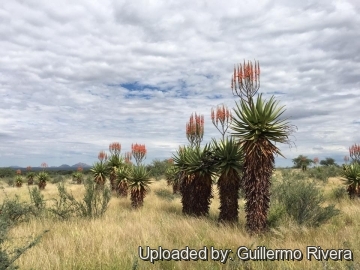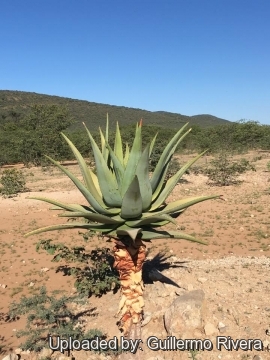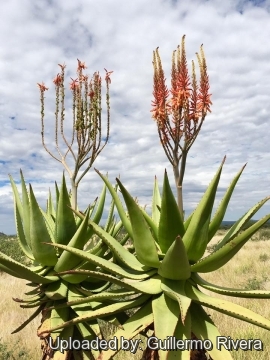
Aloe littoralis Photo by: Guillermo Rivera
Origin and Habitat: Aloe littoralisSN|12293]]SN|12293]] is a widespread species ranging from the Limpopo Province in South Africa, to the Zimbabwe, Botswana, Zambia, Angola and Namibia.
Altitude range: 200–1065 metres above sea level.
Habitat and ecology: This species grows in flat, shallow depressions and open seasonal pans, on sandy soils in open bushveld, mopane woodland and grassland, occasionally on calcrete and rocky outcrops. It is particularly frequent through the coast region in coastal hills, but many specimens can be seen near little village (cultivated?). Its preferred habitat is characterised by summer rain and very dry, warm to cool winters.
Synonyms:
See all synonyms of Aloe littoralis
back
Accepted name in llifle Database:Aloe littoralis BakerTrans. Linn. Soc. London, Bot. 1(5): 293. 1878 [1880 publ. Jan 1878] et: Koen. ex Baker J. Linn. Soc., Bot. 18: 176. 1880 [1881 publ. 1880]Synonymy: 4
back
Common Names include:
ENGLISH: Mopane Aloe
AFRIKAANS (Afrikaans): Mopanie-aalwyn, Windhoekaalwyn, bergaalwyn
GERMAN (Deutsch): Bergaloe
HERERO (otjiHerero): otjindombo
VENDA (Tshivenḓa / Luvenḓa): Tshikhopha
Description: Aloe littoralisSN|12293]]SN|12293]] is a perennial succulent herb or small tree, solitary, usually with a thick single-stem, 2-4 m tall clothed with persistent withered leaves. An apical rosette of 30-40 grey-green to reddish leaves about 60 cm long crown the tip of the stem. The leaves are slightly curved with the upper slightly channelled and the lower convex. This species is easily distinguished from other tall-stemmed aloes by its much-branched inflorescence up to 1.5 metres tall with numerous, narrowly cylindrical, erect racemes (spikes) of pink to red flower with yellow at mouth. This distinguishing feature can be used in the field to identify this plants, as it can be seen on dead inflorescences which endure for many months.
Derivation of specific name: Latin adjective “littoralis”, pertaining to the sea-shore, first collected near the coast in Angola
Stem: Main stem 2-4 m tall, simple usually erect, as thick as a man's arm, rarely thicker entirely covered with the remains of the old leaves. Populations from the open pans in northern Botswana tend to produce acaulescent plants.
Leaves: 30 to 40 succulent in a compact rosette. Lamina ensiform, lanceolate, acuminate, slightly channelled above and convex beneath 30-65(-90) cm long, 5-13 cm wide low down, arcuate-erect with lower leaves slightly spreading, greyish-green to yellowish green, sometimes tinged reddish in dry conditions, unspotted, or with few white spots on upper and lower leaf surfaces on young plants. Margin cartilaginous, yellow, with stiff reddish-brown teeth, spreading, horny, deltoid, 2-4 mm long and 10-15(-20) mm apart. Sap drying yellow.
Inflorescences: Scape 1.0-1.5(-2) m tall above the leaf rosette including the inflorescence, up to 10-branched, the lower branches normally rebranching. Branches arching upwards bearing the racemes erect, subtended by deltoid bracts about 15 mm long and 15 mm wide, with a few sterile bracts below each raceme. Racemes conical-cylindrical, sparsely flowered, 30-60 cm long and about 6 cm in diameter. Bracts ovate-lanceolate, rather longer than the pedicels 9-18 mm long 4-8 mm broad, 5-many-nerved, whitish and deflexed in fruit. Pedicels 6–10 mm long elongating to about 15 mm in fruit.
Flowers: Rose-red or pink turning yellowish near the tips, rarely dirty yellow, cylindric-trigonous, 23-34 mm long, 6 mm in diameter across the ovary. Perianth 25 mm long; tube very short. Outer segments fused in lower half, with slightly recurved tips; inner segments free but fused to outer in lower half. Pedicels 6-8(-12) mm long. Stamens as long as the perianth. Anthers exserted 1-5 mm. Ovary 5-8 mm long, 2-4 mm broad, olive-green. Style exserted 2-10 mm.
Blooming season (in habitat): Variable according to locality (In South Africa mainly from February to March, in Namibia from July to August).
Fruit (capsules): Oblong-ovoid, pale greyish-brown18-28 mm long, 10-15 mm in diameter.
Seeds: About 8.5-9 mm long, 4-4.5 mm broad and 1.5 mm thick, charcoal-grey, with broad, white or pale grey, dark-spotted wing.
Bibliography: Major references and further lectures
1) J. G. Baker. “Flora of Tropical Africa”, Vol 7, 1898
2) Ernst Schmidt, Mervyn Lotter, Warren McCleland “Trees and Shrubs of Mpumalanga and Kruger National Park” Jacana Media, 2002
3) J.P. Roux “Flora of South Africa”, 2003
4) S. Kativu “Flora Zambesiaca” FZ, Vol 12, Part 3, page 48, 2001
5) Raewyn Adams “Aloes A to Z” Lulu.com, 2015
6) Doreen Court “Succulent Flora of Southern Africa” CRC Press, 01 June 2000
 Aloe littoralis Photo by: Guillermo Rivera
Aloe littoralis Photo by: Guillermo Rivera North of Namibia. The older leaves are often cut clean, the locals use the leaves for something. Photo by: Guillermo Rivera
North of Namibia. The older leaves are often cut clean, the locals use the leaves for something. Photo by: Guillermo Rivera Aloe littoralis Photo by: Guillermo Rivera
Aloe littoralis Photo by: Guillermo RiveraSend a photo of this plant.The gallery now contains thousands of pictures, however it is possible to do even more. We are, of course, seeking photos of species not yet shown in the gallery but not only that, we are also looking for better pictures than those already present.
Read More...













